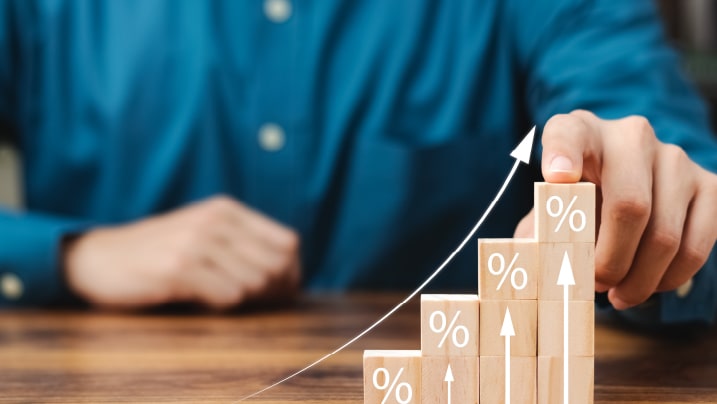Economists say the Reserve Bank faces the delicate task of raising its key interest rate fast enough to quell inflation but without causing so much “climb shock” to household budgets that the economy stalls.
According to Bloomberg, the central bank board meeting on Tuesday with economists almost evenly split between tipping the cash rate, which will be lifted by 25 basis points to 0.6% or 40 bases to 0.75%. Any rate rise would be the RBA’s first back-to-back monthly increase in 12 years and possibly the biggest jump since a 50 basis point hike in February 2000.
“They should put rates up to 0.75% at least, just because inflation is as high as it is and employment [is] as strong as it is, so real interest rates are substantially negative,” said Warwick McKibbin, an Australian National University monetary policy professor and a former RBA board member during the bank’s last flurry of rate rises.
“That’s very stimulative to the economy,” he said. “The question is, do we need that much monetary stimulus where we still have what fairly substantial federal government spending’s first interest rate rise in more than 11 years landed smack in the middle of the national election campaign last month, arguably denting the Morrison government’s claims to be good stewards of the economy. However, the new treasurer, Jim Chalmers, now faces the prospect of regularly explaining why rates are rising, with investors betting on a steady and steep increase for months to come.
Ahead of tomorrow’s anticipated interest rate rise by the RBA, here’s what investors are expecting. About a 70% chance of a 40 basis point rise to 0.75%. #auspol pic.twitter.com/UrMc8qpOHR
— Peter Hannam (@p_hannam) June 5, 2022
The RBA last month estimated the headline inflation rate would rise to 5.9% by the year’s end, a figure that now looks conservative as food and, lately, energy costs spike.

“Because of the war in Ukraine but also because of the disruption of electricity generation in Australia, there’s quite a significant energy price shock going through the system,” McKibbin said. The “substantial shift” in energy prices will probably last beyond short-term weather events and push costs up across the economy.
Sarah Hunter, KPMG’s senior economist, said it was clear the RBA had to bring interest rates back to more normal levels “as soon as practically possible” to rein in inflation. The challenge thought, “to do so without creating ‘climb shock’ by moving rates too fast too soon”.
Hunter said the bank typically adjusted rates by 25 basis points and “w,e expect the RBA to continue to make normal moves”.
Sally Tindall, research director at financial comparison site RateCity, said “there was every chance” the RBA could raise rates by more than a quarter of a percentage point.
“With petrol and grocery prices continuing to shoot up, the case for a 0.40 percentage point hike is strong,” Tindall said. “Central banks worldwide are struggling to get on top of inflation, and the [RBA] does not want to be one of them. The board will want to nip this in the bud.”
Increase monthly repayments based on an owner-occupier paying principal and interest with 25 years remaining.
According to RateCity, owner-occupiers with 25 years to go on their mortgages can expect to pay $13 more monthly for each $100,000 in debt they owe for a 25 basis point increase, assuming commercial banks pass on such an increase. At 40 basis points, the monthly repayments would rise by about $21 per $100,000.
The major banks are predicting the RBA will lift the cash rate multiple times this year. Applying typical conditions for a 25-year mortgage, the repayments burden will swell notably by the end of this year, with more pain to come next year, RateCity said.
The total increase in monthly repayments from the start of hikes. Based on an owner-occupier paying principal and interest with 25 years remaining
The underlying economy remains strong, though, including GDP growth in the March quarter that was slightly quicker than economists had predicted. So-called stress testing by regulators indicates most households are well placed to absorb the costs.
New data out on Monday from ANZ also showed Australia’s job adverts increased modestly in May but remained close to the highest level in about 14 years. Compared with January 2020, ad numbers have risen by about 55% just before the pandemic.
Ahead of the RBA’s decision, job ads are edging higher, according to @ANZ_Research. There are still fewer job vacancies than unemployed people, the bank notes. (Unlike in the US, where there are 2X, vs. 0.8 here). pic.twitter.com/xdDP2k5hpT
— Peter Hannam (@p_hannam) June 6, 2022
McKibbin, who was part of an RBA board that lifted the cash rate six times in seven meetings, said the RBA should raise the cash rate to 0.75% on Tuesday but will probably resort to a quarter-point hike to 0.60%.
“I think that [the cash rate] should be at least around 1% at the moment,” he said. “They’ve got a long way to go to get back where I think they should be.”
Back in 2009-10, during the last flurry of rate hikes, the RBA was dealing with the excessive demand stimulus as governments and central banks responded to the global financial crisis by spending too much and cutting rates too far.
Sign up to receive an email with the top stories from Guardian Australia every morning.
This time around, a similar overshoot during Covid has been compounded by disruptions to global trade because of pandemic restrictions and, more recently, Russia’s invasion of Ukraine and subsequent sanctions.
The challenge for the RBA is determining how much of the inflation stems from excessive demand that can be reduced by making loans more expensive, McKibbin said, adding we should get a clearer picture in the commentary accompanying Tuesday’s rates decision.
“It’s going to be very interesting; it’s not just the change [in rates],” he said. “It’s what RBA governor Philip Lowe says because that will be critical now.”












